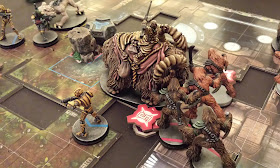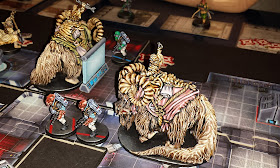All we needed was the right scenario...
And so the scenario we drew was "The Art of Robotics" from the Wookiee Warriors Ally Pack. Which side would triumph by exploiting secret cybernetic technology?
The map contained two Droid Prototypes (signified in our game by two Assassin Droids). At the end of each turn, controlling one of these Prototypes was worth a whopping 8 points. And, a player who controlled a Terminal would be able to move each Prototype up to 4 spaces. In other words, this was a scenario where control and position would generate a lot of Victory Points.
 |
| Development Facility (courtesy of Ibsh) |
The Mercenaries set up in the blue zone, and the Rebels in the red. We were separated in the Northwest Corner by only a couple doors, but to the Southeast lay the valuable Droid Prototypes -- who could get there first?
The Mercenary Force: Banthakrieg!
Deployment Cards: Bantha Riders x2; Beast Tamer (attached to one Bantha); Boba Fett; Nexu; and Hired Guns.
Command Cards: Celebration, Crush, Element of Surprise, Ferocity, Jundland Terror x2, Mandalorian Tactics, Opportunistic, Rally, Roar, Set a Trap, Size Advantage; Survival Instincts; Take Initiative, and Urgency.
 |
| "I will have my army of unstoppable Bantha Cyborgs!" |
Strategy: The two deadliest resources available to a Mercenary player are Boba Fett and the Bantha Riders. So why not combine them? After all, they are oddly compatible. Both are alarmingly fast, rushing far head most other units. But they're also durable and damaging. My strategy was to soften up my opponent's toughest units with the charging Banthas. Then Boba (and the Nexu) could swoop in and prey upon the most wounded. It would be a blitzkrieg, but with water-buffaloes instead of tanks.
The Rebel Force: Gaarkhan and his Wooks
Deployment Cards: Gaarkhan, Wookiee Warriors x4.
Command Cards: Adrenaline, Counter Attack, Cripple, Furious Charge, Hard to Hit, Pummel x2, Rally, Recovery, Roar, Self-Defense, Take Cover, Urgency, Wookiee Rage x2.
 |
| So much Wookiee in such a small space. |
Strategy: General Patton said "A good plan, violently executed now, is better than a perfect plan next week." With 9 rampaging Wookiees, the Rebel plan was all about violent execution. The Wookiees would charge hard and mince up anything that got in their way. However, to avoid having his Wookiees crushed en masse by the Banthas, Nicos tried to space out their attack, spreading his warriors out and dividing my own forces.
 I honestly don't know how -- in a straight up fight -- anything in Imperial Assault can stand up to an army like this one. It's a matter of arithmetic. These 9 Wookiees have a combined health of 98. They can roll up to 18 attack dice on any given turn, including 9 of the deadly red dice.
I honestly don't know how -- in a straight up fight -- anything in Imperial Assault can stand up to an army like this one. It's a matter of arithmetic. These 9 Wookiees have a combined health of 98. They can roll up to 18 attack dice on any given turn, including 9 of the deadly red dice. By way of comparison, my force has a total of 65 health -- which is normally quite good -- and rolls 13 attack dice.
However, one of the great things about Imperial Assault is that it's not a simple slugfest, as this mission will show...
Turn 1: First Blood
Hired Guns always get the worst jobs. In this case, they were given the task of seizing and holding the central Terminal in the face of the onrushing Wookiees. No probs.
 |
| What could possibly go wrong? By the way, have you heard from Greedo lately? |
The Rebels were not far behind. While Boba Fett wounded a Wookiee Warrior with a long-distance shot, Gaarkhan used his Charge ability to rush the nearest Hired Gun and decapitate him.
 |
| "Why do I keep taking these shit jobs?" |
In the northwest corner, both the Wookies and the green Bantha Rider hesitated about attacking each other, thus leaving one Terminal unclaimed. But the Terminal in the centre of the board was possessed by Gaarkhan. Was possessed... until the red Bantha came barreling down the hall, shoving Gaarkhan out of the way and taking the Terminal. This allowed the Mercenaries to move and control one of the Droid Prototypes, generating an early lead.
Mercenaries: 8 points.
Rebels: 0 points.
Turn 2: The Fur Flies
In the Northwest corner, some Wookiee Warriors attempted to take control of a Terminal -- but the green Bantha, emulating his red companion, simply pushed the Wookiees out of the way and sat on the Terminal, preventing any Rebel from accessing it. Meanwhile, the red Bantha rammed into Gaarkhan and his companions, killing Gaarkhan in a bloody stampede.
 |
| I love the smell of Bantha in the morning |
But even as the red Bantha charged, a pack of Wookiees were slashing and stabbing at it. Ultimately, their furious attack took its toll and the great beast listed, groaned and fell, like a battleship heaving to the bottom of the ocean.
However, by occupying the bulk of the Wookiees, the Banthas allowed the Mercenaries to retain control of both Terminals and one Droid Prototype, garnering another 8 points for Boba Fett.
Mercenaries: 24 points
Rebels: 10 points
Turn 3: Red in Tooth and Claw
Although the Mercenaries had a commanding lead in the points, they were now grievously out-numbered in the centre of the board. One Prototype Droid was in Rebel hands and would be impossible to dislodge. To make matters worse, in the northeast corner, three Wookiee Warriors were finally able to bring down their big game prize.
 |
| Aren't Banthas an endangered species? |
The Mercenaries had only 3 models left: Fett, the Nexu and one Hired Gun. Reluctantly, Fett abandoned the idea of killing the swarming Wookiees and concentrated instead on controlling the one remaining Prototype Droid that was still in play. By barricading himself in a corner with the Nexu, the Rebels had no way of getting it. It was now a race to 40 points.
 |
| Guarded by the Nexu, Boba Fett plunders the Prototype Droid |
Rebels: 27 points
Turn 4: So Close and So Far...
Now the climax. The mass of Wookiees dominated the Terminals and could count on getting control of both Prototypes at the end of the round. Nevertheless, if the Mercenaries could earn 8 points by killing one or maybe two Wookiees, they would instantly win the game. Everything was coming down to one desperate push.
Suddenly, the Rebels changed the entire complexion of the game by playing the Adrenaline command card, giving each Wookiee 5 additional health for the entire turn. Now killing these hairy bastards would be nearly impossible during this, the last turn of the game.
 |
| The Final Messy Melee |
And there was only one way to do this: the Wookiees must kill the Nexu. An not just any Nexu. An unharmed, nay, even frisky Nexu. And against the odds, that's exactly what they did. With a couple of powerful slashes, two Wookies Warriors slew the Nexu. Along with control of a Prototype, that was enough for a stunning, come-from-behind Rebel triumph.
Mercenaries: 32 points
Rebels: 45 points
Reflections
This was, hands down, the best game of Imperial Assault that I've played. Up until the last turn, it was unclear who would win, or how it would happen. More importantly, the pack of Wookiees baiting and bleeding their huge prey is an image I'll savour for many weeks.
What surprised me most was how close the Wookies came to losing the game. Although they were (by far) militarily superior to the Mercenaries, strength is not enough in Imperial Assault. Control of objectives and Terminals is vital -- and the Banthas's ability to (literally) sit on a Terminal, denying all other figures any access to it, is a potent strategic tool.
Equally impressive was Boba Fett. He is so fast and so defensive, Nicos made the painful strategic decision to simply leave him alone -- it was too costly to try to kill him. Ultimately, I think this masterful act of restraint was what won the Rebels the game. And indeed, Fett was completely unharmed by the end. Well, that's all to the good. He'll take this defeat in stride. He won't make the same mistake again. He won't go... a Bantha too far.



















